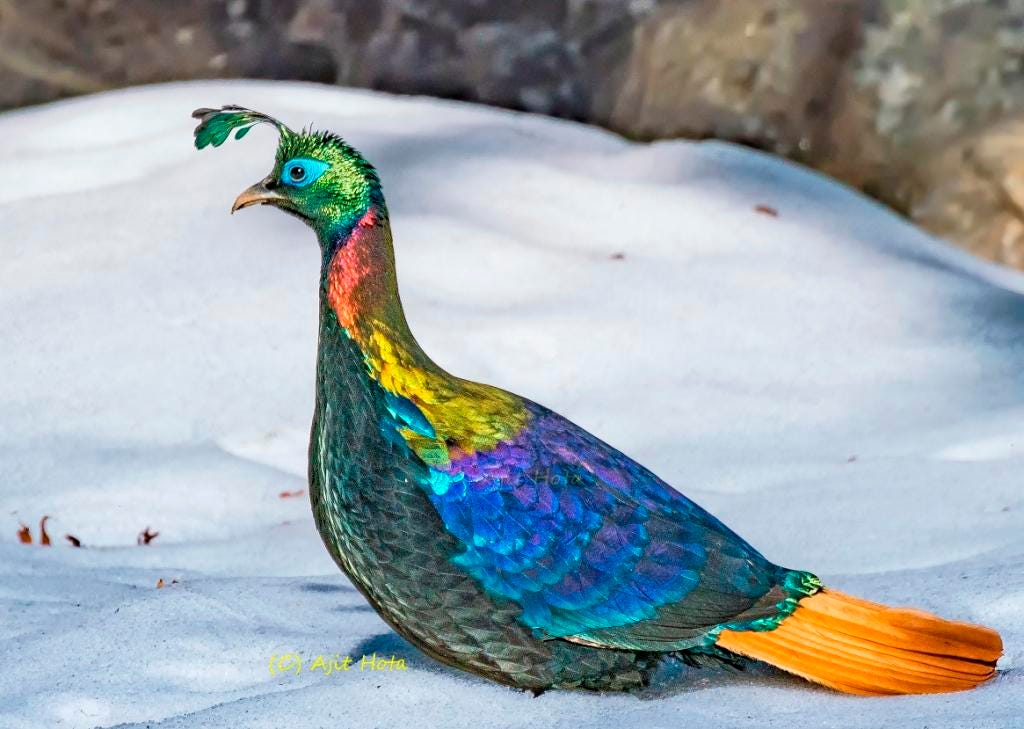
I HAD hoped that relations with my guide would be more convivial on the way to Island Peak Base Camp, as we were now in what is technically known as Very High Altitude terrain.
At this elevation the risk of succumbing to altitude sickness (an illness caused by lack of oxygen in the blood) or to some other danger is so great as to leave little room for error. Proper acclimatisation is the most vital precaution, and on average it is necessary to acclimatise to any altitude over 2,500 metres. The danger goes up exponentially after that. Tengboche is at 3,500 metres, roughly speaking, and Chukhung is 900 metres higher. Island Peak Base Camp is at roughly 5,100 metres.
In the early 1970s, about one in five hundred trekkers in this area used to die, mostly from altitude sickness or some related problem. That’s trekkers: I’m not even talking about serious mountaineers going higher still. These days it’s very rare for anyone to die of altitude sickness on the trekking routes, but only because people are more aware of the issue and of how to tell mild cases from more serious ones.
The most usual symptoms are wheezy lung symptoms. They go from being like a cold, to being like the flu, to being like pneumonia, to being dead. The brain may also swell up as well, a particularly serious complication. It’s thought that about half of all Himalayan trekkers get the milder forms of altitude sickness. If things get serious a person may start coughing up blood. And if a person does start coughing up blood, this is (as always) a bad sign.
To avoid getting altitude sickness, or to limit its likely severity if you do get it, a person has to ascend in stages, like a diver coming up from a great depth. Proper acclimatisation to Himalayan altitudes takes many days of slowly pushing higher and not overdoing things. There is also a medicine called Diamox, though of course it’s better not to get sick in the first place.
So, while common enough in its milder forms, altitude sickness is no joke because it has plenty of potential to get worse, especially if people ignore the early mild symptoms and keep pushing on. This doesn’t have to be upward. Over-exertion on the level can also make a borderline case get worse.
For instance, on the way, we saw a female member of a Russian party slide down a hill. Her friends gave her water and urged her to continue. She was like a leaf in the wind even with her Nordic walking poles, and was at least 100 metres behind her group. Was she fully acclimatised? I don’t know.
The trek to Island Peak Base Camp was an up and down walk, mostly up (some 500 metres). High winds and sleet alternated with sunny intervals during which I took photos. We made it after three hours, eventually.
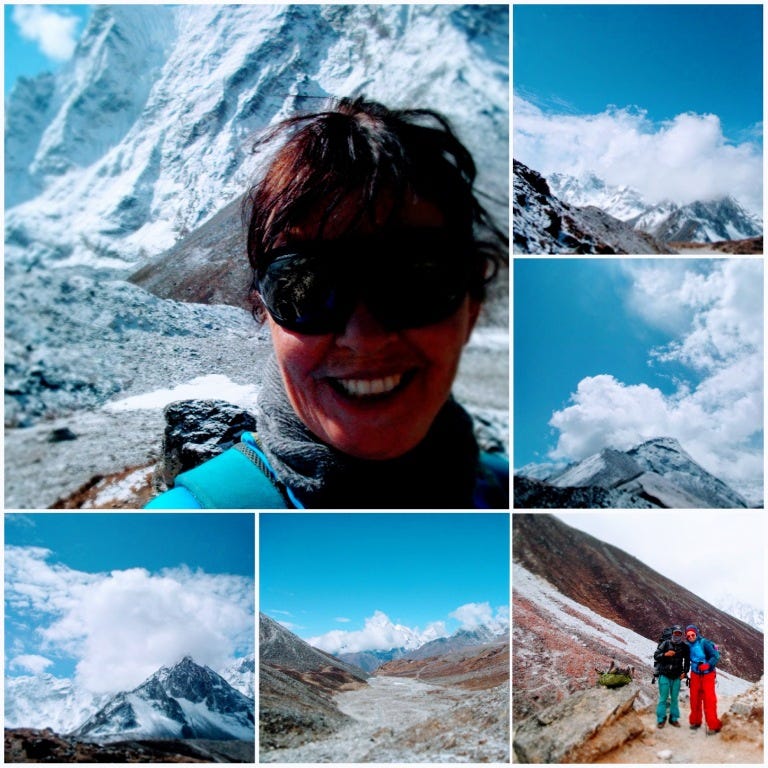
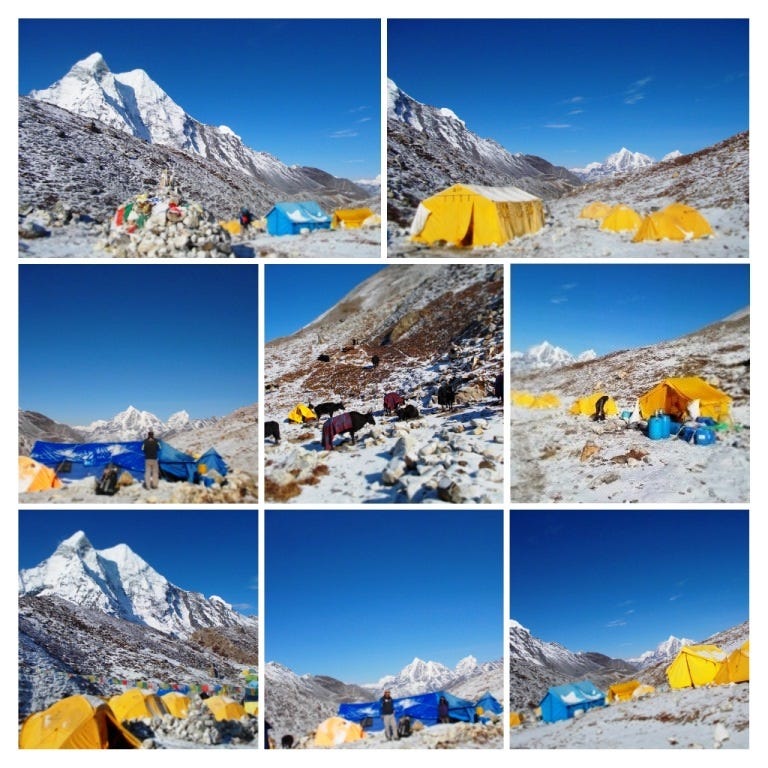
My tent did not close properly, and I was pleased to have two single mattresses to sleep on for extra warmth. Pheasant- or partridge-type birds were everywhere, males and females pairing up for mating.
My guide told me that they were danphe, a species of pheasant which is the national bird of Nepal. So, I took pictures of them as well.
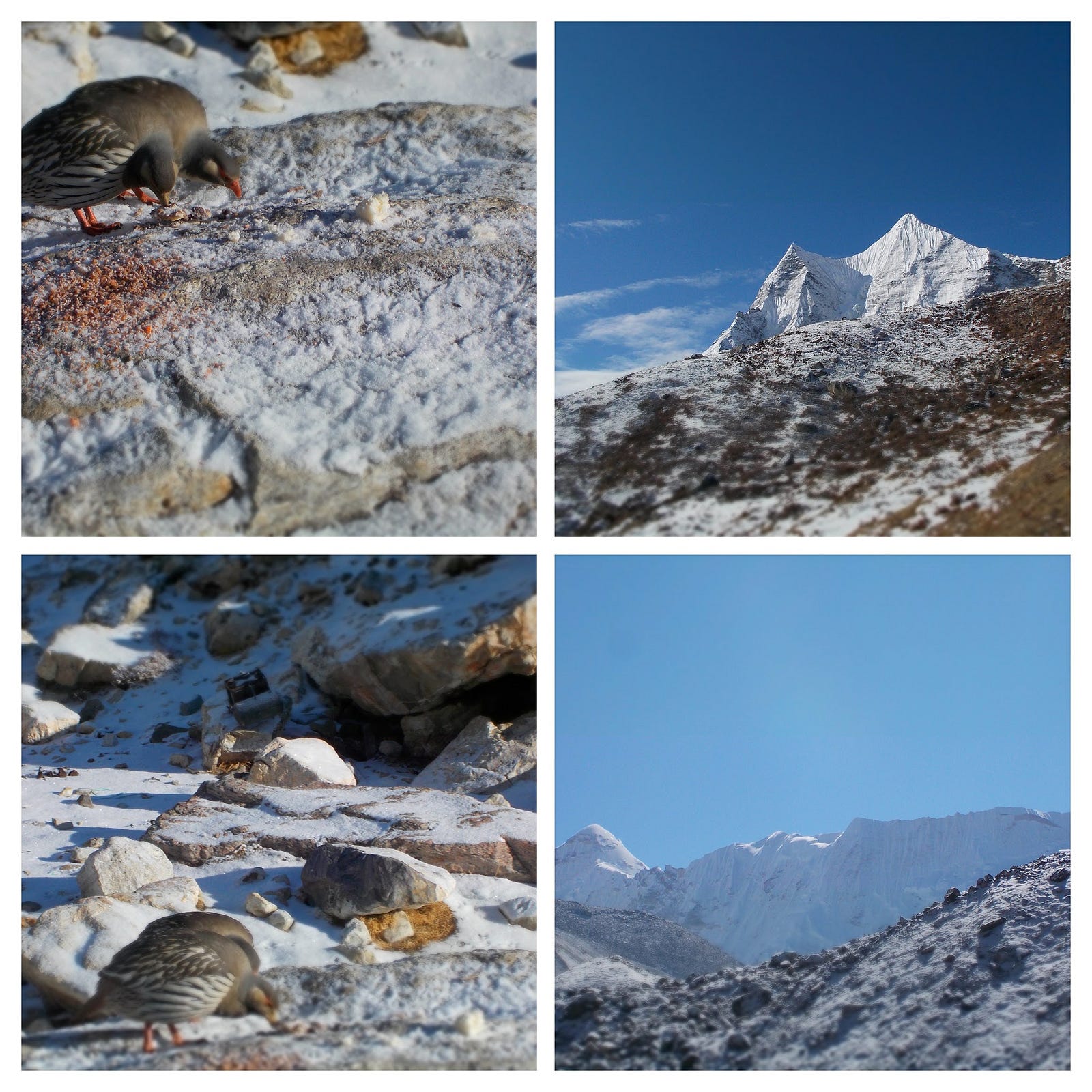
Birds are common even at very high altitudes in the Himalayas, and this is particularly true in the breeding season. They go higher in order to be safe from predators who might otherwise be attracted by their courtship. Birds’ respiratory systems are more efficient than that of human beings and other mammals, which struggle to follow the birds to these altitudes.
Depicted at the start of this essay, the danphe is perhaps the gaudiest of all pheasants. It is Nepal’s answer to India’s national bird, the peacock. It’s a toss-up which is the more spectacular. To my mind the danphe looks like a magical bird from the pages of a fairy tale. The danphe is the avian equivalent of Joseph with his coat of many colours.
Well, the male looks like that. As with all pheasants the danphe hen is a drab creature, much harder to spot. Nature intends it that way, of course. Among heavy, ground-living birds of the pheasant type, it’s vital that the females not attract the attention of predators. The less well-camouflaged males are presumably more expendable.
Though it makes evolutionary sense that the females of big birds that live close to the ground should be harder to spot than the males, the exceptional gaudiness of the male in many species of pheasants, peacocks, and chickens was a poser for Charles Darwin.
He could understand how it made sense to have a well-camouflaged female and a moderately showy male, as with ducks. But how did it make sense for the males to be even more flamboyant than a drake (i.e., male duck)?
Why should heavy birds that lived close to the ground do everything possible to draw a predator’s eye? And to encumber themselves with a great big heavy tail as well, in the case of the peacock?
In the end Darwin concluded that the females of these species must have an eye for beauty that trumped all other considerations; perhaps because gaudiness was also a signal that the male in question was healthy and vigorous.
And so the hen mated with the male who most caught her eye even if he also caught the eye of the tiger a bit later on: with every successive generation of males becoming a bit more conspicuous than the last.
Whether this kind of evolution could go on indefinitely was a good question. In fact, it didn’t seem that it could! Like the antlers of the stag, which served a similar function, the peacock’s tail obviously could not keep on getting bigger, forever, simply to please the pea-hen or, in the case of the stag, the doe.
So, maybe in some cases evolution didn’t always favour the survival of the fittest; at least, not in the long run. Maybe in some cases evolution more or less got side-tracked by mate preference The result was such improbable-looking creatures as the peacock, the danphe and the stag.
Today, we would say such creatures have a place in nature that is like that of a red sports car in a stream of traffic. Practicality and safety have been sacrificed in favour of showing off to the females. And nature has proven as willing to make this expensive choice as some men have.
But the courting pairs we saw were drab in both sexes, the products of a more mundane form of evolution: the family-car variety one might say.
In other words — they weren’t danphe.
Only later would I discover my guide’s misidentification and realise, in the same instant, that it fitted into a wider pattern of unreliability. He didn’t even get Nepal’s unmistakeable national bird right. So what else was he wrong about?
Anyhow, at Island Peak Base Camp the toilet was overflowing. It reminded me of similar sanitary problems at Gorek Shep, near Everest Base Camp, which people sometimes call Gorek Shit.
I was invited to have dinner at 6 pm, which was noodles. I refused as I am gluten intolerant. My Pringles chips came in handy and so did my Snickers bars, as I had purchased three of them. I had to sing out for boiled rice instead of noodles.
The Singaporean trekker Siri, who I introduced in a previous instalment, was at Island Peak Base Camp with his guide as well.
We would be leaving to climb Island Peak, more properly known as Imja Tse, at one am.
My sleeping bag was frozen at one in the morning when we prepared to leave. I had tried to do an equipment check earlier, at the Hotel Sherpaland back in Namche Bazaar, but my guide spoke to someone else on the phone, and never checked my equipment.
Even the night before the climb, my guide had refused to check all my gear. It now turned out that I was missing an additional drinking bottle or a bladder that could take hot water, necessary in the high Himalayas as cold water would freeze. I didn’t have enough for the two of us. What a disaster.
The root of this problem lay in the fact that the hiking gear I had assembled in New Zealand had gone missing on an Air Canada flight from Montreal to Toronto. After a 24 hour flight from Toronto to Nepal via the USA, I tried to buy all the most essential mountaineering gear I needed in Kathmandu in one day, before leaving with my guide. But clearly, one or two things were forgotten.
At 4 pm we made it to Crampon Point, where I discovered that to make things worse still, and in fact hopeless, one of the drink bladders that I did have had been unsuitable for filling with hot water, and had burst.
And so, we turned back to Base Camp at 4 am, arriving at 7 am. The Porter ‘D’ was collecting my bag at 10 am from Base Camp, so I repacked that. We then went on our way to Chukhung. I was not going back to the hotel. Instead, I made my way to Dingboche. I put my orthopaedic insoles into my hiking boots, and wore them.
I went into Mama’s Bakery and the Green Tara again to stay the night. This time around I got to meet Yahjing’s husband Tashi, the former Tibetan monk. I loved meeting Tashi: what a character. My guide did not have to pay to stay here. He had his own room, but had to pay to house and feed the porter.
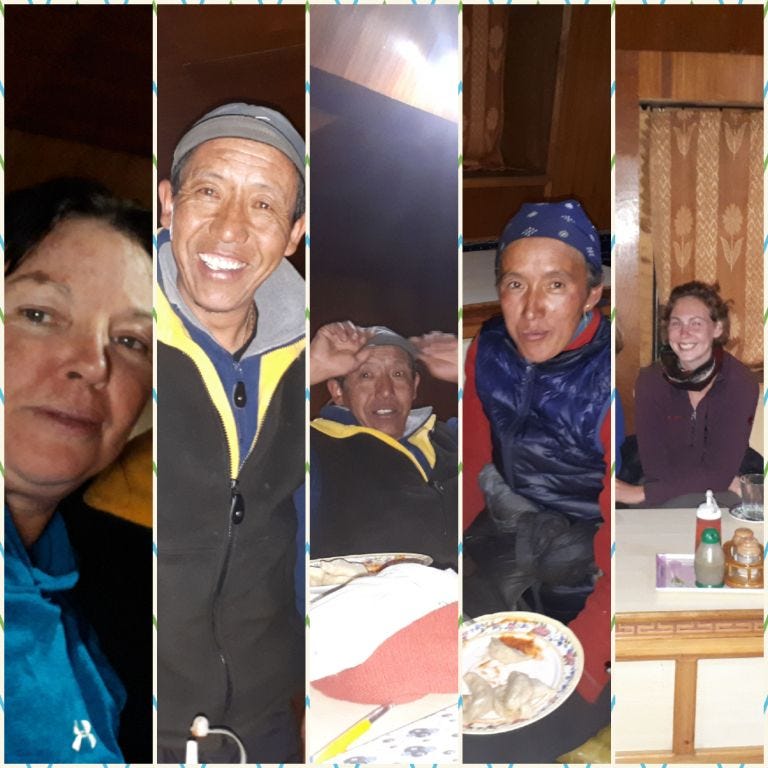
That night, my guide told Tashi that the Dalai Lama was mad and should not follow the Americans. Tashi said that Buddhists do not get into fights, so he got up and left instead. I thought my guide should have been the one to leave the table.
The next day I had coughing fits and was actually coughing blood, and just needed to rest. This was a bad sign of altitude sickness, probably a consequence of our racing ascent to Island Peak Base Camp.
According to the itinerary my guide had drawn up, we were to have climbed Island Peak (6,189 m) on my ninth day in Nepal, after only seven days in the mountains. As it turns out, this was too soon by the recommended standards, whereby the final attempt on such a peak should be left until people have spent about two weeks trekking slowly higher and higher towards it. It’s easy to be wise in hindsight about such things. But of course that’s what guides are meant to be for.
Goodness knows what would have happened if we had not been so short of water to the point of needing every last drop and if one of my water bladders had not then burst. For we would have pressed on to the summit, roughly a thousand metres higher still. And then I might have been overcome by altitude sickness and not been able to make it down, which is another worst-case scenario and a factor in many deaths on Everest and other high mountains.
Mountaineers say that getting to the top is the easy part. It’s coming down when you’re stuffed and quite possibly suffering from altitude sickness that has come on during the climb that is the hard part. And of course you have to get down under your own steam or you will die. That is, barring a rescue which isn’t likely to succeed at Himalayan altitudes and puts other people at risk anyway.
Back in Dingboche (and really we should have been lower still in view of my conditinon), my guide was overheard outside the bakery saying he wanted to change hotels. He asked me if he could save money by having the porter share his free room. I said he should come to some financial arrangement with Tashi all the same. I told Tashi, but he never charged.
Tashi was a great story teller. We had monks visiting the bakery-cum-lodge, and at night Tashi talked about how at age twelve in 1985 he had escaped from Tibet, riding in a truck that crossed over the Indian border.
Tashi said that young Tibetans these days had forgotten their culture and smoked and drank and rode motorbikes.
However, the Dalai Lama ran Tibetan schools that enjoyed some degree of tolerance from the Chinese authorities. Tashi hoped for more autonomy for Tibet. The present Dalai Lama has predicted that he will live to be 113 years old and will witness such a development before his demise.
Interestingly enough, Tashi’s surname was Lama, which means Priest. And it turned out that my guide’s great-grandfather came from Tibet as well.
My guide liked Yahjing and Tashi’s momo dumplings, too. But his behaviour seemed erratic. Tashi offered free meditation and other help to guests, and made a point of extending this offer to my guide.
I warmed to Tashi, who took pity on my guide and treated him with compassion. The next day we were going all the way to Namche Bazaar, so I chose a small hotel run by a friend of Tashi’s. I wanted to keep the peace, but I knew I had to finish this expedition somehow. My guide was weird, and I had to leave.
To be continued . . .
Here is my Amazon author page. I’m also publishing my books, progressively, on other platforms.
Subscribe to our mailing list to receive free giveaways!